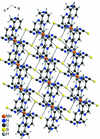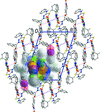issue contents
August 2021 issue

Cover illustration: Single-crystal and powder diffraction investigations of the corticosteroid tixocortol pivalate (commercially branded as Pivalone®) revealed two polymorphs, I and II. The crystal structures show similar O—H⋯O hydrogen bonding, but are distinct in that I is fully ordered and forms layers parallel to (010), whereas II exhibits disorder and packs with layers parallel to (001). See: Rousselin, Yolka & Clavel [Acta Cryst. (2021). E77, 809–813].
research communications
Download citation


Download citation


In the crystal structure of the title compound, the manganese cations are octahedrally coordinated by the N atoms of four 3-(aminomethyl)pyridine co-ligands and two terminal N-bonded thiocyanate anions. The metal cations are linked into layers by the co-ligands, and these are further connected into a three-dimensional network by intermolecular N—H⋯S hydrogen bonding.
CCDC reference: 2092830
Download citation


Download citation


In diethyl 2,2-dioxo-4-(thiophen-2-yl)-1-[(thiophen-2-yl)methyl]-3,4,6,7,8,8a-hexahydro-1H-pyrrolo[2,1-c][1,4]thiazine-1,3-dicarboxylate, the pyrrolo ring is in an envelope conformation while the thiazine ring adopts a near chair conformation. The dihedral angles between the thiazine ring and the methylthienyl, thienyl and pyrrolo rings are 64.0 (2), 87.92 (7) and 5.6 (2)°, respectively. In the crystal, the molecules are linked by weak C—H⋯O hydrogen bonds.
CCDC reference: 2092264
Download citation


Download citation


The asymmetric unit contains one-half of the formula unit of the title compound. The crystal structure is stabilized by intermolecular C—H⋯O, C—H⋯Cl and C—Cl⋯π interactions, and short intermolecular Cl⋯O and Cl⋯Cl contacts, forming a three-dimensional network.
CCDC reference: 2094787
Download citation


Download citation


The crystal structures of three isomers of (E)-4-chloro-N-{2-[2-(chlorobenzylidene)hydrazinyl]-2-oxoethyl}benzenesulfonamide, namely, (E)-4-chloro-N-{2-[2-(2-chlorobenzylidene)hydrazinyl]-2-oxoethyl}benzenesulfonamide (I), (E)-4-chloro-N-{2-[2-(3-chlorobenzylidene)hydrazinyl]-2-oxoethyl}benzenesulfonamide (II) and (E)-4-chloro-N-{2-[2-(4-chlorobenzylidene)hydrazinyl]-2-oxoethyl}benzenesulfonamide (III), with the general formula C15H13Cl2N3O3S are described, with the chloro group in ortho, meta and para positions in the benzylidene benzene ring. All the three isomeric compounds crystallize in the centrosymmetric triclinic P![[\overline{1}]](/e/issues/2021/08/00/mw2177/teximages/mw2177fi1.svg) space group with one molecule each in the asymmetric unit and two molecules in the unit cell. In all the three crystals, the molecules form inversion dimers with
space group with one molecule each in the asymmetric unit and two molecules in the unit cell. In all the three crystals, the molecules form inversion dimers with ![[R_{2}^{2}]](/e/issues/2021/08/00/mw2177/teximages/mw2177fi2.svg) (8) ring motifs, which are further augmented by C—H⋯O interactions.
(8) ring motifs, which are further augmented by C—H⋯O interactions.
Download citation


Download citation


In the molecular structure of the title compound, the urethane function and the benzoyl group are almost perpendicular to each other [dihedral angle 88.97 (5)°]. In the crystal structure, infinite supramolecular layers in the bc plane are formed by weak C—H⋯O hydrogen bonds.
CCDC reference: 2094771
Download citation


Download citation


The title thiourea derivative adopts a U-shaped conformation, which incorporates an intramolecular amine-N—H⋯N(imine) hydrogen bond. In the molecular packing, supramolecular chains are formed through hydroxyl-O—H⋯S(thione) and amine-N—H⋯O hydrogen bonding.
CCDC reference: 2092413
Download citation


Download citation


The structure of the first metal complex of octaethyl pyrophosphoramide is a dimer containing two calcium ions bridged by two nitrate and two octaethyl pyrophosphoramide ligands. Each calcium ion is further coordinated by a nitrate ion acting as a bidentate ligand and a water molecule and has a coordination number of 8.
CCDC reference: 2094905
Download citation


Download citation


The investigation of the coordination chemistry of rare-earth metal complexes with cyanide ligands led to the isolation and crystallographic characterization of the LnIII cyanotriphenylborate complexes, LnCl2(THF)4(NCBPh3) (Ln = Dy, Y) as well as the cyanoborates [NEt4][B3(μ-O)3(C6H5)4], [NEt4][NCBPh2(μ-O)BPh2], [K(crypt)]2[B3(μ-O)3(C6H5)4][NCBPh2Me]. The [NCBPh2(μ-O)BPh2]1− and (NCBPh2Me)1− anions have not been structurally characterized previously.
Download citation


Download citation


The chemical structures of two withanolides, isolated from the leaves of Physalis angulata by column chromatography, were studied. The isolated compounds are (17S,20R,22R,24R,25S)-5β,6β:20,24-diepoxy-4β,25-dihydroxy-1-oxowith-2-en-26,22-olide and (20R,22R)-5α,14α,20-Trihydroxy-1-oxo-6α,7α-epoxywitha-2-enolide.
Download citation


Download citation


Two orthorhombic polymorphs of the anti-inflammatory corticosteroid tixocortol pivalate have been identified. The two structures are characterized by layers of molecules connected by strong O—H⋯O hydrogen bonds.
Download citation


Download citation


In the crystal, molecules of the title compound are connected through C—H⋯π, C—Cl⋯π, Cl⋯Cl and Cl⋯H interactions, generating a three-dimensional network.
CCDC reference: 1987627
Download citation


Download citation


The syntheses and crystal structures of two bimetallic molecular compounds, namely, bis(6,6′-dimethyl-2,2′-bipyridine)copper(I) hexafluoridozirconate(IV) 1.134-hydrate, [Cu(dmbpy)2]2[ZrF6]·1.134H2O (dmbpy = 6,6′-dimethyl-2,2′-bipyridyl, C12H12N2), (I), and bis(6,6′-dimethyl-2,2′-bipyridine)copper(I) hexafluoridohafnate(IV) 0.671-hydrate, [Cu(dmbpy)2]2[HfF6]·0.671H2O, (II), are reported. Apart from a slight site occupancy difference for the water molecule of crystallization, compounds (I) and (II) are isostructural, featuring isolated tetrahedral cations of copper(I) ions coordinated by two dmbpy ligands and centrosymmetric, octahedral anions of fluorinated early transition metals.
Download citation


Download citation


The molecule adopts a Z-shaped conformation with the carboxyl group nearly coplanar with the dihydroquinoline unit. In the crystal, two sets of C—H⋯O hydrogen bonds form chains along the b-axis direction, which are connected into corrugated layers parallel to (103) by additional C—H⋯O hydrogen bonds. The layers are connected by C—H⋯π(ring) interactions.
CCDC reference: 2097267
Download citation


Download citation


The dihedral angle between the aromatic rings in the title compound is 31.84 (8)°; N—H⋯O and C—H⋯O hydrogen bonds and π–π stacking interactions connect molecules in the crystal, producing a three-dimensional network.
CCDC reference: 1878189
Download citation


Download citation


The pyran ring is modestly non-planar while the tetrahydrodiazepine ring adopts a boat conformation. In the crystal, N—H⋯O hydrogen bonds and slipped π–π stacking interactions build a three-dimensional network structure.
CCDC reference: 2097593
Download citation


Download citation


The N2S2 donor set about the zinc atom in the title complex has a geometry approaching tetrahedral. A linear supramolecular chain featuring amine-N—H⋯O(nitro) hydrogen bonding is noted in the crystal.
CCDC reference: 2097106
Download citation


Download citation


A new type of uranium polyoxo cluster complex consisting of thirteen uranium atoms, [U13(μ4-Ooxo)8Clx(MeO)38-x] (x = 2.3, MeO: methoxide), was synthesized and structurally characterized by single crystal X-ray diffraction.
CCDC reference: 2069007
Download citation


Download citation


The title molecule is built up from a ferrocene unit disubstituted by an S-protected diphenylphosphine group and by a methylvinylketone chain. In the crystal, weak C—H⋯O and C—H⋯S interactions build a two-dimensional network.
CCDC reference: 2099273


 journal menu
journal menu




































